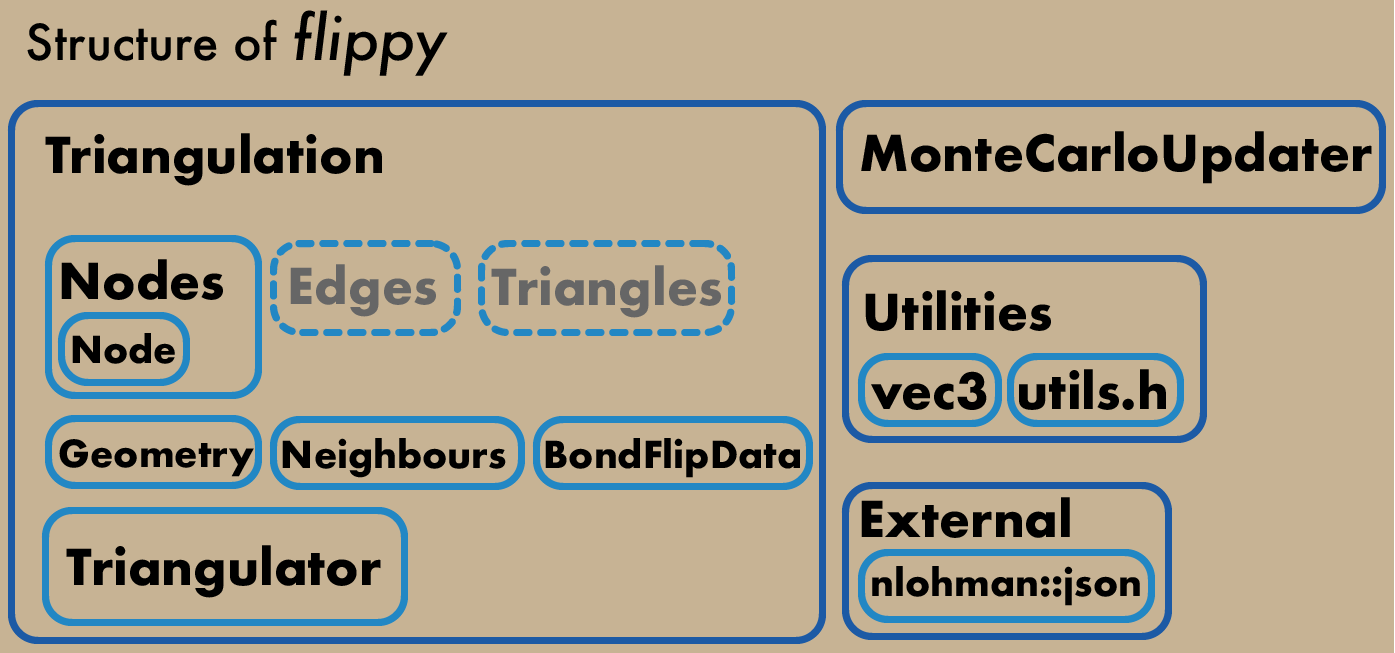|
flippy
a c++20 package for dynamically triangulated membrane simulations.
|
|
flippy
a c++20 package for dynamically triangulated membrane simulations.
|
At its core flippy is a triangulation that can be dynamically and consistently updated. Meaning that flippy provides a triangulation that the user has access to and is able to deform using flippy's high level interface, while flippy takes care of keeping the geometry and topology of the geometry consistently up to date. This main function is performed through the Triangulation class. Once instantiated it contains and keeps track of the triangulated surface and provides the user with methods to change the position of individual nodes and rewire the edges between them, while taking care of the bookkeeping. This means that when a node is moved the triangulation class will automatically update all the local and global geometric values that changed due to this move, like local and global node area. Triangulation distributes its work and data management on other classes that it is composed of (contains instances of). In particular the information on individual nodes is held in the Nodes struct. Information on Edges and Triangles at this point must be derived also from the Nodes struct. For example through querying the next neighbours information from a node. However, an implementation of Edges and Triangles structs is planned.
Flippy also provides a support class called MonteCarloUpdater that provides and interface to create simple monte carlo simulations that update the triangulation the Metropolis–Hastings algorithm. However, the design of this support class presents a tradeoff between simplicity and completeness. MonteCarloUpdater is most useful for simple MC simulations of a single triangulation, for more complex systems a custom updating routines should be written by the user, for which the interface of the Triangulation class should be used directly.
This is the full API documentation provides the full description the public API of flippy, as well as a holistic overview of ts structure. In parallel, we provide demo implementations of several model systems that make use of flippy. These demos can be found in the demo sub-folder in the GitHub repository, together with comprehensive readme files that describe the physics and the implementation of individual simulations.
Information on how to get flippy and incorporate it in your project can be found in the readme of the GitHub repository under the heading How to get it.

|
|---|
Fig. 1. flippy's highest level interfaces are the Triangulation and the MonteCarloUpdater classes. The Triangulation class is composed of many data structures, and provides an interface to them for the user, or uses them internally for its own function. Classes named in gray with dotted outlines are not implemented but are planned. |
All class methods in flippy use similar prefix based naming convention that is described in the table below.
| prefix | description |
|---|---|
| calculate_ | Indicates that a calculation will happen when the method is called, which might be expensive. |
| [action]_ | [action]_ could be move_ or flip_ or any other descriptor. This prefixes indicate a state change and are usually expensive. |
| [no prefix] | usually signifies functions that return a constant reference to a private member (some people use get_ prefix for this). Example: In the triangulation class mass_center() returns a const reference to the private data member mass_center_. |
| [experimental]_ | this method data member etc. Is at this point an experimental feature. This means that it is not thoroughly tested and it is not a stable part of the API. |